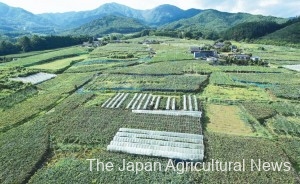YAMANASHI, Nov. 6 — The Kyoutou region of Yamanashi Prefecture in central Japan boasts more than 1,200 years history of fruit cultivation and is a place where cultivation of grapes began in Japan.
The region, consisting of the cities of Yamanashi, Fuefuki and Koshu, is located in the Kofu basin, roughly 100 kilometers — within a 90-minute drive or train ride — from Tokyo. Most of the agricultural land in this region is located on an alluvial fan with substantial slopes and undulations.
Yamanashi Prefecture is the country’s top producer of grapes, peaches and plums, thanks to Kyoutou’s alluvial fan fruit cultivation system, which is included in the list of Globally Important Agricultural Heritage Systems by the United Nations’ Food and Agriculture Organization.
Sanae Sawanobori, who runs a grape farm in the city of Yamanashi with her husband, is also an organic agriculture researcher and cultivates 20 varieties, including table grapes and grapes used to make wine.
According to Sawanobori, the main feature of Kyoutou’s fruit cultivation is its agricultural biodiversity.
More than 300 fruit tree varieties, including 148 grape varieties, as well as peaches, plums and persimmons, are grown in the region. Surveys also confirmed the presence of 269 plant species and 555 insect species in the region.
“Even local people were surprised to learn that so many creatures live in the orchards,” Sawanobori said.
One of the reasons for the abundance of species is the native vegetation ground cover employed in orchards.
Such floor management in orchards not only prevents soil erosion on sloping ground and supplies organic matter to the soil but also provides habitats for plants and insects.
The fact that farmers in the region work on a small plot of land, about 60 to 70 ares, offered favorable conditions for the creatures.
Even when one field is sprayed with chemicals, creatures can scatter in search of places to escape in neighboring fields.
Small family-run farms led to production of a wide range of fruit varieties and wildlife conservation.


